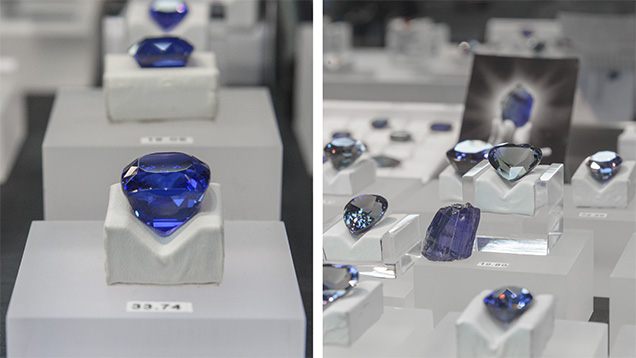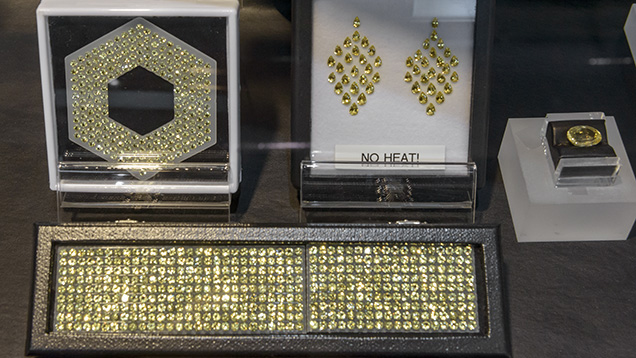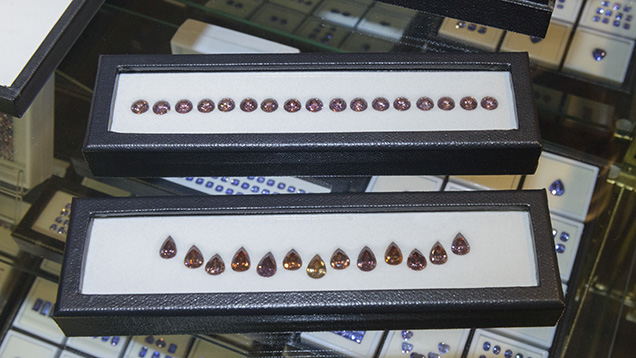Natural-Color Tanzanite and Yellow Sapphire – Tucson 2014

While it is easier to buy unusual-colored tanzanite rough today, the material still is not available in abundance. Sevdermish informed us that what he calls “fancy-color” tanzanite comes from the same area as the familiar blue to bluish purple tanzanite. The rough pieces he displayed in Tucson had greenish, golden, green blue, pink, and purplish pink colors. The rarest are greens, followed by golden hues. These stones were best sellers for the company in 2013.
Kobe Sevdermish
Advanced Quality, Ltd.
Advanced Quality, Ltd.
In these three videos, Israeli dealer Kobe Sevdermish introduces us to the subtle beauty of unheated tanzanite, bright yellow African sapphire much in demand among his clientele as a fancy color diamond substitute, and the rich earthy colors of heated zircon from Tanzania.
According to Sevdermish, the U.S. market is full of “regular” heated tanzanite, and people are looking for something unique. Clients are especially taken with sets where each stone displays a slightly different color. In his opinion, the luster of the unheated stones is significantly better. Sevdermish ensures that no heating is performed on any of the rough he selects. All stones are polished at the company’s factory in Bangkok.After describing a large piece of highly transparent rough that took a week to purchase, Sevdermish showed us the two significant pieces cut from it: a 50.61 ct green-blue oval and a spectacular 19.80 ct greenish blue heart with arresting green and blue green pleochroism cut from the top part of the crystal.

Figure 2. Precision-cut unheated yellow sapphire sold well to buyers looking for yellow diamond substitutes. Photo by Eric Welch; courtesy of Advanced Quality.
He called our attention to precision-cut unheated yellow sapphires (figure 2) arranged as sets or as precisely cut calibrated shapes, including ovals, pears, and princess cuts. Sevdermish described this corundum as a “true canary color,” which is unusual in a natural-color sapphire. He said most of the strong yellow sapphire on the market is either heated or beryllium-treated.All the rough is carefully selected for color consistency in order to avoid greenish or grayish hues. Sevdermish estimated they select about 5% of the rough production, suitable for cutting into 2–5 mm finished stones, from a small mine in Africa. Material for 0.50 or 1 ct sizes is very rare. Sevdermish said his clients like the material because its clarity, color, and polish give it the look of fancy-color diamond.

Figure 3. These heated Tanzanian zircons displayed a range of warm pinkish to yellowish brown colors. Photo by Eric Welch; courtesy of Advanced Quality.
Finally, Sevdermish showed us what he described as “fancy vivid” pink zircon from Tanzania (figure 3). The zircon was heat-treated, lightening the original color of the rough to reveal pinks with cinnamon tints. Further heating lightens the color a little more, producing very bright, lively stones. The only downside, Sevdermish remarked, is the name “zircon.” Customers tend to confuse the name with “cubic zirconia,” which makes them reluctant to purchase the gems until they understand that zircon is a natural stone.


